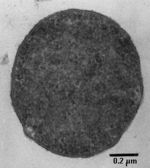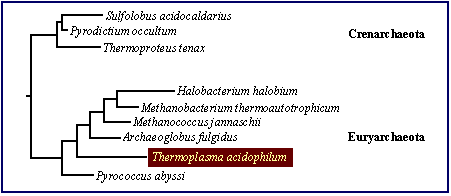Thermoplasma acidophilum
A Microbial Biorealm page on the genus Thermoplasma acidophilum
Classification
Higher order taxa
cellular organisms; Archaea; Euryarchaeota; Thermoplasmata; Thermoplasmatales; Thermoplasmataceae; Thermoplasma; Thermoplasma acidophilum
Genus
Thermoplasma acidophilum
|
NCBI: Taxonomy |
Description and significance
Thermoplasma acidophilum is a thermophilic heterotrophic prokaryote and is "among the most acidophilic organism known.”(2) They grow at 55-60°C and favor a range pH of 0.5-4; It was found and first isolated from self-heating coal refuse piles and solfatara fields. (3)
Scientists have long been fascinated by the ability of this microorganism to grow at high temperatures and low pH, they are specially interested in the protein these organism have because common proteins are denatured under acidic and hot environments without the structural protection of a conventional cell wall.
Thermoplasma acidophilum’s genome contain special gene that allow this organism to survive in an environment similar in temperature and acidity to hot vinegar. (4) By determining and studying the genome sequence of this organism, we will develop a better understanding of protein folding and degradation; it will also present a more complete representation of the proteins involved in different system of our body. (3)
Genome structure
The genome of Thermoplasma is a single circular chromosome (1.56Mbp, containing 1509 ORFs)(4) and it is one of the smallest microbial genomes ever sequenced. (3)
Surprisingly, the characteristics of Thermoplasma acidophilum’s small genome identify these organisms as a“typical euryarchaeon with a substantial complement of bacterial-related genes.” However,massive lateral gene transfer appears to have occurred between Thermoplasma and Sulfolobus solfataricus, "a phylogenetically distant crenarchaeon inhabiting the same environment." (2)
Cell structure and metabolism
Species of the genus Thermoplasma lack a rigid cell wall, but still have a plasma membrane, it is “devoid of protective outer shells (S-layer, cell wall), yet maintains a near-neutral cytosolic pH.” (4)
The lipid composition of T. acidophilum has been the subject of several investigations. This work has revealed the presence of “large polar lipids, often glycosylated with glucose, mannose and glucose, phosphorylated, or both, forming phosphoglycolipids” (5). These unusual lipid compositions allow T.acidophilum to survive under the harsh conditions of temperature and pH“restricting proton flow across the membrane more efficiently than non-branched lipids (6)” As the structure of branched lipid blocks the transport pathway of proton, neutral pH can be maintained within the cell membrane.
The Entner-Doudoroff pathway can only occur in prokaryotes like Thermoplasma. This pathway is a series of reactions that “catabolize glucose to pyruvate using a different set of enzymes other than those used in either glycolysis or the pentose phosphate pathway. Distinct feature of Entner-Doudoroff pathway is that it uses 6-phosphogluconate dehydrase and 2-keto-3-deoxyglucosephophate aldolase to create pyruvates from glucose." (14)
In Thermoplasma, glucose degradation is done by a “non-phosphorylated variant of the Entner–Doudoroff pathway, in which the first step is catalyzed by glucose dehydrogenase.” Acetyl-CoA produced from this pathway enters the TCA cycle. (the presence of this enzyme is requires for this pathway has been experimentally confirmed), the presence of glycolysis/gluconeogenesis has not yet been confirmed due to the absence of phosphofructokinase and fructose in this organism. (7)
Ecology
Thermoplasma acidophilum plays an important role in the ecosystem. They act as scavenger of those extreme environment. “It has adapted to scavenging nutrients from the decomposition of organisms killed by the extreme acidity and requires yeast, bacterial or meat extract when grown in culture.” (3)
The study of Thermoplasma acidophilum indicate that an aqueous extract of coal refuse will serve as a nutrient source. This is the first step leading to the discovery of the materials in coal refuse which support its growth. Indeed, the coal refuse material provides nutrients for the growth of a wide variety of microorganisms and could be a source of new growth factors. (8)
Pathology
None of the archaea organism, including Thermoplasma acidophilum, are known to cause disease in human beings.
Application to Biotechnology
Studies of the 20S proteasome from T.acidophilum has revealed that it's proteolytic mechanism is similar to eukaryotic forms of the enzyme that are clinically relevant. (9)
In higher eukaryotes, the proteasome is involved in housekeeping and protein level regulation; Further understanding of the chemical mechanism of this enzyme can help us to understand disease caused by the mutation of protesomes such as cystic fibrosis, Angelman's syndrome, Parkinson's disease, Liddle syndrome even cancer(10).
"Deregulation of this enzymatic system may also play a role in tumor progression, drug resistance, and altered immune surveillance, making the proteasome an appropriate and novel therapeutic target in cancer."(1) Proteasome also involve in apoptosis, which is a process to safely dispose of cell corpses and fragment. Apoptosis is a main type of programmed cell death, it plays a critical role in preventing cancer; if cell fails to undergo apoptosis, it can continue dividing and develop into tumor. (16)
Current Research
Origin of eukaryotic cell nuclei by symbiosis of archaea in bacteria supported by the newly clarified origin of functional genes of Thermoplasma acidophilum and 21 other unicellular organisms. This striking research suggests eukaryotic cell nuclei also undergo a process call endosymbiosis like mitochondria and chloroplast long time ago. Scientist did this by counting count the numbers of ORF (Orthologous ORFs were produced by speciation from a common ancestor, and have the highest similarity to each other); it was possible to detect the correct orthologous ORFs and to match up the origins of the functional categories in eukaryotic cells. Result find out there are lots of similarities between these two.(18)
The role of hydrophobic interactions in maintaining high temperature stability is investigated by citrate synthase of T.acidophilum as a thermostable model system. Scientist find out increasing or decreasing the hydrophobicity could further increase the thermostability of the T.acidophilum citrate synthase. Therefore, it is assumed that “interface substitutions affecting the entropy of the unfolded state did not prove to be so critical in protein thermostabilization at higher temperatures.” (17)
Tremendous amount of research had been made on 20S proteasome of T.acidophilum, because this enzyme is common in higher eukaryotic organism and can play an important role on medical research. (12) Scientist are trying to find a way to deregulate this enzymatic system which might help to suppress or cure cancer, because proteasome involve in apoptosis which plays a critical role in preventing cancer.(16)
References
1. NEWT/ NCBI
2. Brock, T. D., in Thermoplilic microorganisms and life at high temperatures, pp. 92-116 (Springer, Berlin Heidelberg New York).
3. Don Cowan,Nature 407, 466-467,28 September 2000
4.Cedric F.V. Hobel, Sigillum Universitatis Islandiae, Access to Biodiversity and new genes from thermophiles by special enrichment methods, 2004
5. Budgen, N. & Danson, M. J. Metabolism of glucose via a modified Entner–Doudoroff pathway in the thermoacidophilic archaebacterium Thermoplasma acidophilum. FEBS Lett. 196, 207–210 (1986).
6. Gutsche, I. , Essen, L. O. & Baumeister, W. Group II chaperonins: New TRiC(k)s and Turns of a Protein Folding Machine. J. Mol. Biol. 293, 295– 312 (1999).
7.Searcy, D. G. & Whatley, F. R. Thermoplasma acidophilum: Glucose degradative pathways and respiratory activities. Syst. Appl. Microbiol. 5, 30–40 (1984).
8. Darland, G., Brock, T.D., Samsonoff, W. & Conti, S.F. A thermophilic acidophilic mycoplasm isolated from a coal refuse pile. Science 170, 1416-1418 (1970).
9. Zwickl, P. , Ng, D. , Woo, K. M. , Klenk, H. P. & Goldberg, A. L. An archaebacterial ATPase, homologous to ATPases in the eukaryotic 26 S proteasome, activates protein breakdown by 20 S proteasomes. J. Biol. Chem. 274, 26008– 26014 (1999).
10. Voges, D. , Zwickl, P. & Baumeister, W. The 26S proteasome: A molecular machine designed for controlled proteolysis. Annu. Rev. Biochem. 68, 1015–1068 (1999).
11.Bijal P. Trivedi, T. acidophilum living the hot, acidic life, Genome News Network Sep 29, 2000
12. Keiji Tanaka and Tomoki Chiba, The proteasome: a protein-destroying machine, The Tokyo Mtropolitan Institute of Medical Science, 1998
13. Wolf S, Lottspeich F and Baumeister W, Ubiquitin found in the archaebacterium Thermoplasma acidophilum, 1993 Jul 12
14. Mohamed, M. Optometry Professor. Smith, K. Optometrist. Sohn, S. Biomedical Science Professor.
15. J B Almond and G M Cohen, the proteasome: a novel target for cancer chemotherapy, Leukemia (2002) 16, 433-443. DOI: 10.1038/sj/leu/2402417
16. Murphy, KM et al (2000). "Bcl-2 inhibits Bax translocation from cytosol to mitochondria during drug-induced apoptosis of human tumor cells". Cell Death and Differentiation
17. Erduran I.; Kocab y k S, Biochemical and Biophysical Research Communications, Volume 249, Number 2, August 1998, pp. 566-571(6)
18. Tokumasa Horiike, Kazuo Hamada and Takao Shinozawa. “Origin of Eukaryotic Cell Nuclei by Symbiosis of Archaea in Bacteria supported by the newly clarified origin of functional genes” Genes Genet. Syst. Vol. 77 369-376 (2002) .
--chwon 22:00, 29 April 2007 (UTC)
Edited by student of Rachel Larsen and Kit Pogliano


